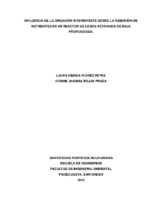Influencia de la aireación intermitente sobre la remoción de nutrientes en un reactor de lodos activados de baja profundidad
Fecha
2018Director/Asesor
Cerón Vivas, Alexandra
Tipo de contenido
Trabajo de grado
Citación
Metadatos
Mostrar el registro completo del ítemDocumentos PDF
Resumen
Este estudio se realizó en la planta de tratamiento de aguas residuales de la Universidad Pontificia Bolivariana seccional Bucaramanga (PTAR-UPB), donde se evaluó la influencia de la aireación intermitente y el tiempo de retención hidráulico (TRH) sobre la remoción de nutrientes en un Reactor de Lodos Activados de Baja Profundidad (RLABP), por medio de tres ciclos de aireación y no aireación (on/off): 90/90, 60/120 y 150/30 min. Se realizaron 5 muestreos compuestos de 6 horas y perfiles de oxígeno disuelto (OD) por cada ciclo de aireación, los parámetros in situ fueron pH. conductividad. OD, temperatura, caudal y los analitos evaluados NO2. NO3. N•NH4. NTK, PO42- y CaCO3. Durante la primera intermitencia (11), se presentaron las mejores eficiencias de remoción de NTK y NH4 con valores entre 13% y 20% respectivamente en su paso por el tren secundario (RLABP); y del 8%y 14% en el tratamiento terciario (buchón de agua). Asimismo, el análisis de los perfiles de OD y nitratos revela que en general, durante 11 se favorecieron procesos de denitrificación durante la secuencia de etapas aerobias-anóxicas-anaerobias (A-A-A); con una duración aproximada de 55 — 20 - 15 min respectivamente. El tratamiento secundario (RLABP) presentó fallas operacionales en la recirculación de lodos activados y no contó con suficiente biomasa, por lo tanto. los ciclos de aireación intermitente, al igual que su interacción con los TRH del presente estudio. no ejercieron efectos significativos sobre la remoción de los compuestos nitrógeno (N) y fósforo (P). This study was developed in the wastewater treatment plant of the Pontificia Bolivariana University, sectional Bucaramanga (PTAR-UPB). where the influence of intermittent aeration and hydraulic retention time (HRT) on the nutrient removal inside a Low Depth Activated Sludge Reactor (RLABP); through three cycles of aeration and non-aeration (on / off): 90/90, 60/120 and 150/30 min. Five composite samples of 6 hours and dissolved oxygen (DO) profiles were performed for each cycle of aeration, the in situ parameters were pH, conductivity, OD, temperature, flow rate and the analyzed analytes NO2, NO3, N-NH4, NTK, PO42- and CaCO3. During the first intermittency (11), the best NTK and NH4 removal efficiencies were presented with values between 13% and 20% respectively in their passage through the secondary train (RLABP); and 8% and 14% in the tertiary treatment (water buck). Likewise, the analysis of OD and nitrate profiles reveals that in general, during 11 denitrification processes were favored during the sequence of aerobic-anoxic-anaerobic stages (A-A-A); with an approximate duration of 55 -20 -15 min respectively. The secondary treatment (RLABP) presented operational failures in the recirculation of activated sludge and did not have enough biomass, therefore, the cycles of intermittent aeration, as well as its interaction with the TRH of the present study, did not exert significant effects on the Removal of the compounds nitrogen (N) and phosphorus (P).
Palabra/s clave
Lodos de perforación
Agua - Aireación
Aguas residuales
Temperatura
Biomasa
Colecciones
- Trabajos de grado [6440]
El ítem tiene asociados los siguientes ficheros de licencia:


